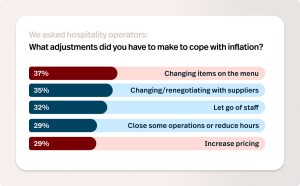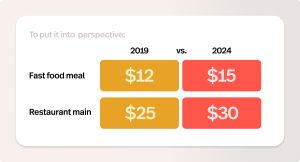
Something has been happening over the past couple of years, and it’s something that won’t have gone unnoticed by most people. I’m talking about inflation.
It seems to have taken the baton from the grip of the COVID lockdowns to become the new obstacle in the ever-growing struggle to live our lives and it’s hitting everybody just the same. The cost of living has become bloated almost to the point of bursting with a rise of between 3.3%-6.5% over the past 12 months.
The hospitality industry is not immune and has, naturally, had to make adjustments to cope with these rising costs.
In Lightspeed’s recent Hospitality Report, we found that 66% of hospitality operators have, one way or another, adjusted their menus to counteract the growing impact of inflation.
In this blog, we’ll explore the different ways in which hospitality operators have adjusted and why these adjustments are not only justified, but possibly still not enough.
- Hospitality report findings
- What the price increases look like
- How menu adjustments can help
- Are price changes here to stay?
2024 Hospitality Insights and Dining Dynamics
Lightspeed has surveyed over 500 hospitality operators and more than 1,000 consumers to show you which dining trends are on the rise in 2024. Download the full report for free today.
Hospitality report findings
Let’s start with our Hospitality Report findings.

Of the 66% that made adjustments to their menus, this can be broken down into 2 categories: changing menu items (37%) and increasing their prices (29%).
This makes sense given that these two methods are the ones most easily controlled by a business. They’re also a lot more favourable than letting go of valuable staff or even entire locations in an effort to make ends meet.
What the price increases look like
When we look a little deeper into what these price increases look like, that’s when we see something interesting.
These are not small increases that could quite easily go under the radar. Rather, they are seismic shifts that cannot help but stand out when it comes time for customers to pay the bill.
Since December 2019, restaurant prices have risen by around 17% with fast food prices rising even further to the tune of around 19%. To put that into perspective, a fast food meal costing you $15 today would only have cost around $12 in 2019, and a restaurant main costing $30 today would equate to around $25.

It’s also telling of how hospitality businesses are adjusting in unison that only 1% of respondents said that inflation did not affect their business. This is a movement by the industry as a whole.
These issues were discussed at Lightspeed’s recent Table Talks event, when Chris Terlikar and Shayne McConachy of Melbourne’s Bluebonnet Barbecue shed some light on how they have increased prices and their reasons for doing it.
“We were paying $350 for a ton, now we’re paying almost a thousand.”
Chris Terlikar: “When we first opened, we were charging $10 for 100g, and now we’re charging $15 for 100g, so the price of meat has doubled, but we’re only charging an extra 50% on top, so there are a lot of challenges. Even firewood. We were paying $350 for a ton, now we’re paying almost a thousand.”
As you can see, although their prices have increased by 50%, there’s still a reluctance to pass all of the additional costs onto the customer, with only half of their own costs for purchasing the raw ingredients covered by price increases. And that’s before you factor in the losses they’re taking on for their firewood.
It is a promising sign though that where hospitality businesses are usually delicate in their pricing adjustments, we’re seeing them applying a far heavier hand in order to catch up with years of wearing their own increasing costs.
Why are these price increases so severe and why are they happening now?
As mentioned, the hospitality industry is usually reluctant to implement any radical price increases, but this is changing.
One of the main reasons for these changes is the cost of supplies and although these look to be stabilising, at their peak they signalled trouble for any operator who dared not increase their prices.
Inviting instant feedback
But this is a double-edged sword.
Unlike other industries, hospitality almost invites its customers to provide instant feedback. Whether that be based around quality of service, the products themselves or, crucially here, the prices, hospitality consumers are seldom shy to offer up their feedback.
Shayne McConachy: “Trying to communicate that to our customers, you know, through price increases on the menu isn’t really received well. And sometimes it’s hard not to take it personally, trying to sort of pinpoint, have we done something wrong?”
And once these increases are actioned, that isn’t the type of trigger that can be unpulled. These price increases are likely here to stay.
How menu adjustments can help
In the same Table Talks event, Attica’s General Manager, Claire Stenhouse, talked about how they combat high costs in a more innovative, sustainable way.
“Eat The Problem Lasagna”
“Cows destroy the land so, because of that reason, we don’t serve any animals like that. In fact, the vegetables are more expensive than meat. So we have our hunter guy that sends us down the byproduct of the fashion industry, and we’ve got something called the Eat The Problem Lasagna, the problem being all these animals that come over to the land with their hoofs and things like this.
“So we’ve got wild boar, venison and buffalo—all prevalent in Australia—but should not be here, so we put them in a pasta. It’s the most sustainable way to solve the problem.”
This is a prime example of a business changing their menu to adapt to inflation. Figuring out the cheaper alternatives and working them into their offerings without sacrificing quality. The fact that it can also tie in some sustainability goodwill points is a bonus, but something that actually comes as part and parcel when you take such a route.
Consider the idea of seasonality.
Ingredients, when in season, are both in abundance and at their peak in terms of quality and this applies to both produce and livestock. Their abundance when in season keeps their cost down, and using them in these windows of availability keeps their growing and nurturing sustainable, giving things the time to regenerate before going again the following year.
This gives hospitality operators an opportunity to create an operating model set up to keep their costs low and their quality high without risking the wrath of customers who might feel price gouged.
Are price changes here to stay?
Price increases and menu adjustments are here to stay. This might upset some people, but with the recent inflation, this is an opportunity for the hospitality industry to implement some increases in prices that have been a long time coming.
The costs of running a business have increased on the back of COVID’s supply chain issues and these were exacerbated by the rapid inflation of the past couple of years. The hospitality industry is doing what most other industries have been doing the whole time and even then, as discussed by Chris and Shayne from Bluebonnet, it still leaves some hospitality operators out of pocket.
And with innovative ways to adjust menu items in order to lower costs, quality doesn’t have to be sacrificed. There can be lower COGS with higher quality, you just need to do some research about seasonality or, as is the case with Melbourne’s Attica, get the right contacts and think outside the box a little.
2024 Hospitality Insights and Dining Dynamics
For a full breakdown of what customers and operators expect to see in 2024, download the full 2024 Hospitality Insights and Dining Dynamics Report now.

News you care about. Tips you can use.
Everything your business needs to grow, delivered straight to your inbox.


